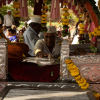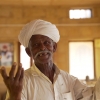Ram Gopal, the legendary dancer, was born at the mansion-like Torquay Castle, Benson Town (now the YMCA), Bangalore, to a Burmese mother and a Rajput father on November 20, 1912. He was given the additional name Bissano (born on 20th, bees in Hindi). Drawn to dance very early in life, Ram’s debut was an impromptu performance at the Mysore Palace at the behest of the prince of Mysore and there was no looking back.
Ram’s barrister father did not welcome the idea of a dancer son but his mother supported his passion and the Prince of Mysore was impressed enough to become Ram’s patron. Ram went on to learn a smattering of styles as was the vogue those days but mastered only Bharatanatyam. He learnt Kathakali from Guru Kunju Kurup at Kalamandalam while Vallathol Narayanan Menon himself presided there. He also learnt Bharatanatyam from two stalwarts of that time—Guru Meenakshisundaram Pillai and Guru Kattumanarakoil Muthukumaran Pillai. Ram Gopal further added to his repertoire Kathak, which he learned from Gurus Jailal and Sohanlal.
So Ram Gopal received extensive training in three prevalent styles of those days. He is said to have once remarked, ‘my left side is Bharatanatyam and the right side is Kathakali, in my legs lies Kathak.’ It would be accurate to call him India’s first international classical dancer, for it was indeed Ram Gopal who was the first one to present the variety of Indian classical dance styles and their rich vocabulary to a Western audience.

It was actually his partnering with La Meri, the American ethnic dancer, that brought him to the notice of the world in 1936. She took him on an extended tour of Burma, the Malay States, Penang, Singapore and Japan. In Japan, where Ram and La Meri parted company, he met the Polish critic Alexander Janta, who became his guide, manager and impresario, and they landed in America together. Travelling through Hollywood to New York, he was introduced to the American impresario Sol Hurok by Cecil B. De Mille. Sol Hurok arranged a season for Ram, much in the way he had arranged one for Uday Shankar earlier. By the time Ram left for Europe, his feet were firmly established in three continents.
Later Ram toured the world many times over. He received rave reviews from Western critics who called his dance an 'unearthly beauty', another called it 'unearthly physical control' while yet another wrote that 'to see him is to realise the essence of dancing'. The Polish critic Tadeus Zelinski called him 'the Nijinsky of India'.
Ram was the first to team up with women dancers such as Tara Chaudhri, Shevanti, Mrinalini Sarabhai, Retna Mohini (wife of the young and upcoming photographer Henri Cartier Bresson), M.K. Saroja and Kathak dancer Kumudini Lakhia. He created travelling dance companies, the likes of which the Western world had never seen. But he gave credit for his inspiration to the other leading light of his times—Uday Shankar, whose work had preceded Ram’s by a decade. There was a difference though. Uday Shankar had formulated and presented his own non-classical style, whereas Ram Gopal presented only a classical repertoire.

He danced at some of the most famous and reputed theatres of the world—The Grand Theatre, Opera House in Poland, the Palais Du Louvre and Musée Guimet in Paris, the Aldwych in London and the Town Hall in Stockholm (where the Nobel Prize Ceremony is conducted).
One thing led to another. His friends, and their friends in turn, helped build Ram’s outreach. Mercedes de Costa (after whom the car is named) came to Paris from America to introduce Ram to Gertrude Stein. In her turn, Miss Stein introduced Ram to several leading personalities of the theatre world, one of them being the prima ballerina of Russia, Princess Krasinky Kshesinskaya. Kshesinskaya showed Ram around her studio and also included him in the Gala de Dance presented at the Louvre to raise funds for Vaslav Nijinsky. Ram later said, 'I realised then how important security is for artists, especially as we creative folks are prone to squandering more than we earn.'
Ram Gopal was very concerned that there should be no monotony or repetition in his presentation, something he observed and learnt from Uday Shankar’s. Even while touring India, he had realised that classical dance presentations were not widely enjoyed as the audience could not understand the language of the songs that accompanied the dance or even the meaning of the hastas (hand gestures). He worked on making each item in his repertoire very precise and compact, so the item conveyed what it had to without becoming overdrawn. He also paid special attention to costumes, reproducing for stage what he saw and understood from Indian paintings and sculptures. In the 1940s, Ram met Mahatma Gandhi several times. And it was the Mahatma who suggested that he provide some kind of an explanation, an introduction to each piece before it was danced. This process worked in India, so Ram applied it in the West too. Ram also interspersed his dance presentations with short musical items. This helped in introducing Indian instruments to a Western audience.

Ram Gopal’s magic lasted far beyond his active dancing years. He immortalised himself through two films made on him—Aum Shiva and Ram. David Lean was planning a film on the life and dance of Ram Gopal. Unfortunately, Lean died while the script and the shooting of the film were in progress.
Ram published two books—Indian Dancing in 1951 and his autobiography, Rhythms in the Heavens, in 1957. He also briefly opened two dance schools—one in Bangalore before he moved to England, and the other, Academy for Indian Dance and Music, in London in 1962. His later years were spent in London, Venice and the South of France.
After a not very successful attempt to settle down in his native Bangalore, Ram Gopal lived out the last three years of his life in South London. His stay was sponsored by the family of the late Claude Lamorrise, French patroness and longtime friend, The Croydon Council and the Royal Ballet Benevolent Fund. He died on Sunday, October 12, 2003 at the Norbury Care Home. Pamela Cullen, another friend, had looked after him in his last years. She was also the executor of 'The Ram Gopal Estate'. For his services to dance, Ram Gopal received the Sangeet Natak Akademi fellowship in 1990 and an Order of the British Empire (OBE) in 1999.
(Information based on Ram Gopal’s autobiography, Rhythms in the Heavens and obituary tribute in the yearbook, attenDance)
Research Associate: Ambika Panikar













